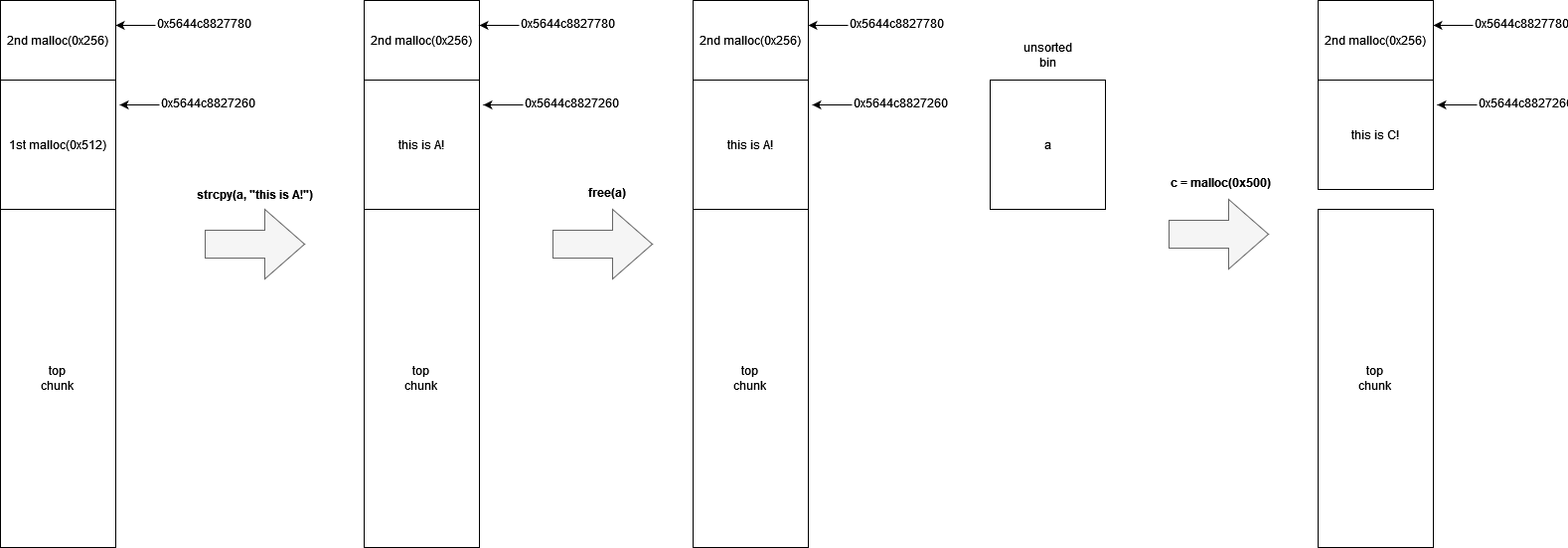how2heap - first fit
first fit
c源码
#include <stdio.h>
#include <stdlib.h>
#include <string.h>
int main()
{
fprintf(stderr, "This file doesn't demonstrate an attack, but shows the nature of glibc's allocator.\n");
fprintf(stderr, "glibc uses a first-fit algorithm to select a free chunk.\n");
fprintf(stderr, "If a chunk is free and large enough, malloc will select this chunk.\n");
fprintf(stderr, "This can be exploited in a use-after-free situation.\n");
fprintf(stderr, "Allocating 2 buffers. They can be large, don't have to be fastbin.\n");
char* a = malloc(0x512);
char* b = malloc(0x256);
char* c;
fprintf(stderr, "1st malloc(0x512): %p\n", a);
fprintf(stderr, "2nd malloc(0x256): %p\n", b);
fprintf(stderr, "we could continue mallocing here...\n");
fprintf(stderr, "now let's put a string at a that we can read later \"this is A!\"\n");
strcpy(a, "this is A!");
fprintf(stderr, "first allocation %p points to %s\n", a, a);
fprintf(stderr, "Freeing the first one...\n");
free(a);
fprintf(stderr, "We don't need to free anything again. As long as we allocate smaller than 0x512, it will end up at %p\n", a);
fprintf(stderr, "So, let's allocate 0x500 bytes\n");
c = malloc(0x500);
fprintf(stderr, "3rd malloc(0x500): %p\n", c);
fprintf(stderr, "And put a different string here, \"this is C!\"\n");
strcpy(c, "this is C!");
fprintf(stderr, "3rd allocation %p points to %s\n", c, c);
fprintf(stderr, "first allocation %p points to %s\n", a, a);
fprintf(stderr, "If we reuse the first allocation, it now holds the data from the third allocation.\n");
}
执行后
This file doesn't demonstrate an attack, but shows the nature of glibc's allocator.
glibc uses a first-fit algorithm to select a free chunk.
If a chunk is free and large enough, malloc will select this chunk.
This can be exploited in a use-after-free situation.
Allocating 2 buffers. They can be large, don't have to be fastbin.
1st malloc(0x512): 0x5644c8827260
2nd malloc(0x256): 0x5644c8827780
we could continue mallocing here...
now let's put a string at a that we can read later "this is A!"
first allocation 0x5644c8827260 points to this is A!
Freeing the first one...
We don't need to free anything again. As long as we allocate smaller than 0x512, it will end up at 0x5644c8827260
So, let's allocate 0x500 bytes
3rd malloc(0x500): 0x5644c8827260
And put a different string here, "this is C!"
3rd allocation 0x5644c8827260 points to this is C!
first allocation 0x5644c8827260 points to this is C!
If we reuse the first allocation, it now holds the data from the third allocation.

free(a)
pwndbg> bin
tcachebins
empty
fastbins
0x20: 0x0
0x30: 0x0
0x40: 0x0
0x50: 0x0
0x60: 0x0
0x70: 0x0
0x80: 0x0
unsortedbin
all: 0x555555757250 —▸ 0x7ffff7dcdca0 (main_arena+96) ◂— 0x555555757250 /* 'PruUUU' */
smallbins
empty
largebins
empty
A lion doesn't concern himself with the opinions of a sheep.


 浙公网安备 33010602011771号
浙公网安备 33010602011771号